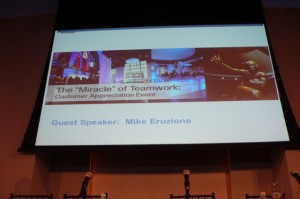
Beautiful but destructive
A recent ice storm left 1.25 million residents of the Northeastern United States without power this past weekend, a powerful reminder of the need to prepare for the “everyday disaster”. The affected area stretches from Maine to Pennsylvania, with the Governors of Massachusetts and New Hampshire declaring emergencies in their states and calling up the National Guardsmen. Utility crews from as far away as South Carolina are joining the effort to restore power with the expectation that some homes and businesses will be without power until next week. For small businesses facing the threat of power failure, your contingency plan should address the following needs:
Continuity of telephone communications.
Analog lines work if your area is experiencing a power outage as the lines are powered by the phone company. For small business use, it is rarely cost-effective to implement redundant phone circuits. If the telephone service fails, it is most likely due to a service outage, not to the actual hardware. But even if it is the actual hardware, since nearly everyone has a cellular telephone, it is the natural backup solution for your land-based circuits. The question is how to automatically connect land- and cell phone-based service so the cell phone service would take over if the land lines fail. The problem is that once the land lines have failed, it is not possible to forward land-line calls to the cellular phones. The second issue to consider is the likelihood of failure of cell phones in a major power outage as towers to relay signals will be depleted of reserve power.
The solution is developed by thinking in reverse. You give out the cell phone number as your general contact number. You program the phone such that any incoming call is forwarded to your land-based phone when the cellular phone is switched off. If your land-based line fails, simply switch on your cellular phone. Thus, in a localized disaster that displaces you from your office (such as the terrorist attacks of 9-11), the cell phone provides service. In a broader disaster such as a large-scale power outage, when cell phone stations are depleted of power with which to relay signals, use your analog phone to receive and make calls without interruption. (Remember that the phone must be directly connected to the analog line; a hand-held phone will be disabled by a power outage.)
Continuity of voice mail.
Sign up with a voice mail provider that delivers your messages over the Internet via e-mail. In fact, you should sign up with an integrated voice and fax service. This service often costs less than a regular phone line. Single providers of only voice mail or fax delivery via the Internet are usually not cost-effective. Since the Internet has been designed to automatically re-route traffic if one or many paths no longer work (the opposite of the “cascade effect” that disables electrical supplies across a wide grid), as long as you can connect to the Internet from somewhere (such as from a battery-powered laptop), you can receive your e-mails and hence, your voice messages and faxes. If both your land-based phone service and your cell phone service fail, your calls or faxes are forwarded to your integrated service number. You could even configure your system in such a way that it automatically sends you a short notification message with a summary of your voice or fax message to your cell phone or pager. It is a service you will enjoy during normal operations as it reduces unnecessary calls to your cellular phone.
Protection of computers and data.
Even when electrical power is available, there are quality issues, like peaks in voltage as well as micro-outages. Since IT equipment is sensitive, use an uninterruptible power supply unit (UPS), which is usually a surge protector, together with a small buffer battery that would supply energy for about 10 minutes after the electricity supply is terminated, enough to finish important work and to shut down the system. Most units support an automatic shutdown before the battery is completely depleted. Some buildings supply self-generated backup power. Please note that this power is usually much “dirtier” than power from the outlet. Under these circumstances, you must use a UPS unit, preferably one that is designed to smooth out erratic electricity supply.
Certain high-rise apartment and office building have back-up generators that provide low levels of power for up to fourteen hours after termination of the central electrical supply. Many workers and residents of these buildings mistakenly believed that a volt of electricity is a volt of electricity irrespective of whether it comes from the central utility or a back-up generator. During the recent power outage, they used their home and office computers with electricity delivered from a back-up generator, without the benefit of a UPS unit, and damaged their computers in the process. Also, remember to turn off appliances and equipment during a power outage as power supply may be erratic when it is initially restored.
Basic measures of preparation.
Of course, all of the basic measures for preparation apply (keeping battery-operated radios, extra batteries, non-perishable foods, flashlights, bottled water, etc.) for both your home and your office. It may seem obvious, but a glance at the people queued up at stores for such supplies on the evening of August 14, 2003 (when a massive outage left 50 million people in the U.S. and Canada without power) suggests that these measures were not obvious to everyone. It also bears repeating that measures recommended for small business contingency will yield immediate benefits to your business in terms of improved operating efficiencies, even if disaster never strikes. Finally, remember that each suggestion put forward for small business contingency solutions can be applicable to home and to personal needs.








